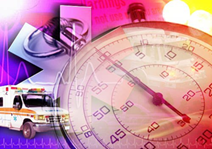October 12, 2018

National Public Safety Telecommunications Council
NPSTC Submitted Comments on the Vertical (Z-Axis) Accuracy Metric Proposed by the Nationwide Wireless Carriers. The Public Safety and Homeland Security Bureau of the FCC asked for comments on a proposed z-axis metric for 9-1-1 location accuracy, submitted by CTIA for the nationwide wireless carriers. The 16 member organizations of NPSTC said the proposal for a +/- 5 meter vertical accuracy metric failed
 to offer the level needed to protect the public in emergency situations. A +/- 5 meter level of accuracy equates to a total potential error span of 10 meters, i.e., approximately 33 feet or 3 floors. If a family, trapped by fire, is mistakenly identified as being on the tenth floor, instead of the twelfth floor, where they actually are, lives can be lost.
to offer the level needed to protect the public in emergency situations. A +/- 5 meter level of accuracy equates to a total potential error span of 10 meters, i.e., approximately 33 feet or 3 floors. If a family, trapped by fire, is mistakenly identified as being on the tenth floor, instead of the twelfth floor, where they actually are, lives can be lost.

Public safety needs floor-level accuracy for the z-axis metric and, therefore, NPSTC said that the z-axis recommendation from the nationwide carriers was unacceptable. This conclusion also considered, 1) test results submitted by providers of vertical location technology that show a 1.8 meter accuracy level is possible; 2) the vast resources nationwide carriers have at hand, as affirmed in their respective 2017 annual reports; and 3) the very generous timeline for vertical location implementation the Commission has provided. Given the technology and resources available to provide floor-level accuracy, NPSTC believes floor-level accuracy is what is needed and should be required. Additionally, the Commission's definition of dispatchable location, in the previously defined rules, should not be diluted.
NPSTC and NASEMSO Release White Paper: Pre-Hospital Notification in Time-Sensitive Medical Emergencies: What EMS Agencies and Emergency Departments Should Know. Since the elapsed time from the onset of symptoms to appropriate treatment is a critical component in many medical emergencies, it is clear that EMS plays a significant role in the care and long-term outcomes for these patients. One crucial step in reducing delays in treatment during time-sensitive medical and traumatic emergencies is efficient pre-hospital notification.
Successful pre-hospital notification protocols have a number of benefits to the patient, as well as to the EMS agency and the hospitals involved, but there are also
 challenges. These include the use of disparate or inefficient technologies, lack of effective policy, and the need for appropriate training. New emerging technologies such as the advent of the National Public Safety Broadband Network (NPSBN) and Next Generation 911 (NG-911) will greatly increase the ability of EMS to provide enhanced information to hospital Emergency Departments (ED). The EMS Working Group, a collaboration of the National Public Safety Telecommunications Council (NPSTC) and National Association of State EMS Officials (NASEMSO), has published a report recommending best practices in this area and advocating that EMS agencies and EDs revisit their current prehospital notification processes. The White Paper also describes the current landscape and emerging technologies.
challenges. These include the use of disparate or inefficient technologies, lack of effective policy, and the need for appropriate training. New emerging technologies such as the advent of the National Public Safety Broadband Network (NPSBN) and Next Generation 911 (NG-911) will greatly increase the ability of EMS to provide enhanced information to hospital Emergency Departments (ED). The EMS Working Group, a collaboration of the National Public Safety Telecommunications Council (NPSTC) and National Association of State EMS Officials (NASEMSO), has published a report recommending best practices in this area and advocating that EMS agencies and EDs revisit their current prehospital notification processes. The White Paper also describes the current landscape and emerging technologies.

On Tuesday, October 23 from 2:00–3:00 p.m. ET, the Interoperability Committee Will Host a Joint Session with the Broadband Emerging Technologies Working Group. Please join NPSTC for a presentation on the emerging role of the COMU [Communications Unit Leader]Program. Officials from the DHS Office of Emergency Communications will provide an update on proposed changes to the COMU Program, including expansion of responsibilities to manage broadband data and IT functions and ongoing discussions to elevate the COMU to a higher level in the ICS structure.
Conference Line U.S.: 510-227-1018; Conference ID: 446-1830#
Screen Share link: https://join.me/npstcsupport1
Screen Share link: https://join.me/npstcsupport1
Join the Common Channel Naming Working Group on Tuesday, October 16, from 12:00–1:00 p.m. ET.
Conference Line U.S.: 510-227-1018; Conference ID: 446-1830#
Screen Share link: https://join.me/npstcsupport1
Screen Share link: https://join.me/npstcsupport1
The Technology and Broadband Committee Will Meet on Wednesday, October 17, from 2:00–3:00 p.m. ET.
Conference Line U.S.: 510-227-1018; Conference ID: 446-1830#
Screen Share link: https://join.me/npstcsupport1
Screen Share link: https://join.me/npstcsupport1
The VTAG Will Hold its Quarterly Meeting on Thursday, October 25, from 11:00–12:00 p.m. ET.
Conference Line U.S.: 510-227-1018; Conference ID: 446-1830#
Screen Share link: https://join.me/npstcsupport1
Screen Share link: https://join.me/npstcsupport1
The EMS Working Group, scheduled for Thursday, October 25, from 11:00–12:00 p.m. ET, Will Not Be Held Due to a Conflict with the NASEMSO Meeting.
Join Us on Social Media
NPSTC Outreach News and Related Public Safety News are now available on NPSTC's blog.
Click on the orange icon above to check it out.
Click on the orange icon above to check it out.









